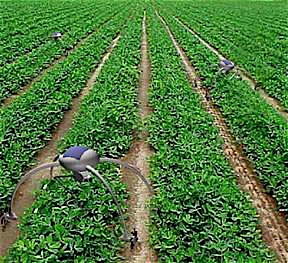Robot System Could Drastically Reduce Herbicide Use
A solar-powered robot with 20/20 vision, on a
search-and-destroy quest for weeds, will soon be moving up and down the crop
rows at the experimental fields at the University of Illinois. What’s
more, this robot has the potential to control weeds while significantly reducing
herbicide use.

A solar-powered robot with 20/20 vision, on a search-and-destroy quest for weeds, will soon be moving up and down the crop rows at the experimental fields at the University of Illinois. What’s more, this robot has the potential to control weeds while significantly reducing herbicide use.
The robot uses GPS for navigation, and there are two small cameras mounted on a frame on top of the machine to give the robot depth perception, just like a human, said Lei Tian, agricultural engineer at the U of I. “If he sees a weed, he can actually tell how far away it is.”
An on-board computer offers access to information that provides the morphological features of plants, to help the robot determine just what is and isn’t a weed. Once a weed is identified, a robotic arm attached to the front of the machine engages a device the researcher calls “a custom-designed end effector.”
There are two layers to the device, according to Tian. One layer cuts the weed, while the second layer applies herbicide to the cut weed.
“This type of application is extremely effective,” said Tian, “because it applies herbicide directly to the plant, instead of broadcasting uniform rates across a field.”
With this level of precision, Tian says the system has clear environmental benefits. In addition to cutting herbicide use, chemicals do not drift off-target when placed directly on the plants.
On a larger scale, they’re also describing a robot that could be used for harvesting and planting. Of course, given enough development, you might end up with reduced "undocumentado" use.
Posted: Fri - October 13, 2006 at 06:32 AM